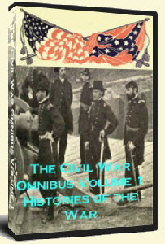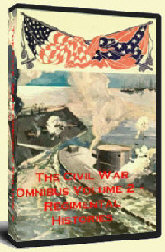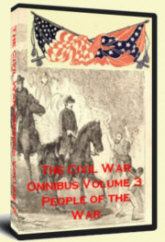It is a fallacy to believe that the entire Northern part of the United States supported the Civil War and President Abraham Lincoln. Copperheads, or Northerners who did not support the war, were a voice of dissidence for much of the war, and no Copperhead was as vocal or dissident as Clement Laird Vallandigham, an Ohio newspaperman and politician.
Born in New Lisbon, Ohio, Vallandigham became a successful attorney who used his success to win election to the Ohio House of Representatives in 1845 and 1846. After moving to Dayton in 1847, he purchased a half-interest in the Dayton Empire. Although he was defeated as a Democrat in congressional elections in 1852 and 1854, he was returned to the House of Representatives after a contested election in 1858. Vallandigham made no bones about his support for state rights, and backed Stephen Douglas in 1860. Read the rest of this entry »
Comments Off on Clement Laird Vallandigham – the Man Without a Country
When the Civil War began, there was no shortage of able bodied men who volunteered for service in both the U.S. Army and the Confederate Army. Eager to show their patriotism, convinced that their cause would be victorious in a matter of months at the most, men gathered in cities and towns throughout America to form volunteer regiments, clamoring to assist in the war effort.
However, by late 1862 and early 1863, the patriotic fervor that had characterized the war effort early on was wearing thin in both the Confederacy and the United States, and finding men to replenish the armies of both nations was becoming difficult. Those who wanted to serve were already engaged; those who did not had either refused to serve, or, having volunteered and found the experience to be much more arduous than it seemed at first, had deserted or refused to re-enlist. This necessitated instituting a draft to choose men for service, and, in both the North and the South, the practice of hiring substitutes to serve in the place of those who were called and did not want to serve. Read the rest of this entry »
Comments Off on Hired Soldiers – Substitutes During the Civil War
If all the pieces had fallen into place, it could have changed the political landscape of American history, if not the world. If the plan would have worked, it could have been one of the most complete political coups in history.
While the assassination of Abraham Lincoln is one of the best known events in American history, it was only one part of a larger plan by John Wilkes Booth that has been largely forgotten, a plan to overthrow the United States government and give the defeated Confederacy the opportunity to shore up their resources and possibly win a war that had already for all intents and purposes ended. Read the rest of this entry »
Comments Off on The Conspiracy
The supporters of the Confederacy found the post-Civil War South a hostile environment indeed. For those of the planter class, the bottom rail was on top. Most were financially ruined by the war. The slaves on whom they had depended to work their land were gone, or, if they stayed, now had the right to be paid wages. Others had no need to worry about slaves to work their properties, because their properties had been seized by the Federal government or lost to creditors. For the men who had served in the Confederate Army as officers, their rights as citizens were stripped.
It is not surprising, then, that as many as 4,000-9,000 of these disenfranchised Southerners took Emperor Dom Pedro II of Brazil up on his offer to relocate to Brazil and cultivate cotton there, and despite being advised by no less than General Robert E. Lee himself against it, set out for South American in search of what they’d lost to the war. Read the rest of this entry »
Comments Off on The Confederados
Feeling that the war was nearing its end, I desired my cavalry to be in at the death.Sheridan on his desire to rejoin the Army of the Potomac
With both Jubal Early and most of the civilians in the Shenandoah Valley still choking on the smoke of “The Burning,” General Philip Henry Sheridan, sensing that the tide of the war was turning toward the destruction of Robert E. Lee and the Army of Northern Virginia, took his men to Petersburg, rejoining the Army of the Potomac. Once again the Army of the Potomac would bask in the glory of “Little Phil,” as it was during this stint with the Army of the Potomac that Sheridan’s reputation as a hero was secured, as he managed to bring down not only Jubal Early’s men, but Lee and the Army of Northern Virginia, as well.
Sheridan wasted no time resting on his Winchester laurels as he ventured to Petersburg. At the Battle of Waynesboro, he forced 1,500 of Early’s men to surrender. Less than month later, he forced Lee to flee Petersburg. Only days later, at the Battle of Sayler’s Creek, Sheridan dealt Lee a final, crushing blow by capturing almost a quarter of his remaining men. Read the rest of this entry »
Comments Off on “Worth His Weight in Gold:” Philip Henry Sheridan – pt. 2


